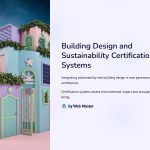 In today’s rapidly evolving architectural landscape, integrating sustainability into building design has become paramount. Sustainability certification systems play a crucial role in assessing and promoting environmentally responsible construction practices. These systems evaluate various aspects of a building’s design, construction, and operation to ensure minimal environmental impact and enhanced occupant well-being.
In today’s rapidly evolving architectural landscape, integrating sustainability into building design has become paramount. Sustainability certification systems play a crucial role in assessing and promoting environmentally responsible construction practices. These systems evaluate various aspects of a building’s design, construction, and operation to ensure minimal environmental impact and enhanced occupant well-being.

Introduction to Sustainability Certification Systems
Sustainability certification systems are frameworks developed to assess and recognize buildings that meet specific environmental performance criteria. They aim to encourage the adoption of green building practices by providing guidelines and benchmarks for energy efficiency, resource conservation, and occupant health. By achieving certification, buildings demonstrate a commitment to environmental stewardship and social responsibility.

Prominent Global Certification Systems
Several sustainability certification systems have gained international recognition for their comprehensive evaluation methodologies. Notable among these are:
- LEED (Leadership in Energy and Environmental Design): Developed by the U.S. Green Building Council (USGBC), LEED is one of the most widely used green building rating systems globally. It assesses buildings across various categories, including energy use, indoor environmental quality, and sustainable site development. LEED certifications are tiered as Certified, Silver, Gold, and Platinum, reflecting the level of sustainability achieved.
- BREEAM (Building Research Establishment Environmental Assessment Method): Originating in the United Kingdom, BREEAM evaluates the sustainability performance of buildings in areas such as energy, health and well-being, materials, and ecology. It provides ratings ranging from Pass to Outstanding, guiding developers towards best practices in sustainable design.
- WELL Building Standard: Focusing on human health and well-being, the WELL certification assesses building features that impact occupant wellness, including air quality, lighting, and comfort. It complements other sustainability certifications by emphasizing the human experience within built environments.

G-SEED: Korea’s Green Building Certification
In South Korea, the Green Standard for Energy and Environmental Design (G-SEED) serves as the national certification system for evaluating the environmental performance of buildings. Jointly administered by the Ministry of Land, Infrastructure and Transport and the Ministry of Environment, G-SEED assesses buildings based on criteria such as energy efficiency, resource utilization, and indoor environmental quality. The certification levels include Green 1st Grade, Green 2nd Grade, and Green 3rd Grade, indicating the degree of sustainability achieved.
G-SEED has been instrumental in promoting sustainable building practices within Korea, encouraging the integration of eco-friendly materials, energy-saving technologies, and designs that harmonize with the natural environment.

The Role of Certification Systems in Sustainable Architecture
Sustainability certification systems play a pivotal role in advancing green architecture by:
- Providing Standardized Benchmarks: They offer clear criteria for assessing environmental performance, enabling consistent evaluation across projects.
- Encouraging Innovation: By setting ambitious targets, these systems motivate architects and developers to explore innovative solutions in design and construction.
- Enhancing Marketability: Certified buildings often enjoy increased market appeal, as they demonstrate a commitment to sustainability, which is increasingly valued by tenants and investors.
- Contributing to Environmental Goals: They support broader environmental objectives, such as reducing carbon emissions, conserving resources, and improving urban air quality.

Challenges and Considerations in Certification
While sustainability certifications offer numerous benefits, there are challenges to consider:
- Cost Implications: Achieving certification can involve additional costs related to design, materials, and documentation. However, these can be offset by long-term savings in energy and maintenance.
- Complexity of Compliance: Navigating the requirements of certification systems can be complex and may require specialized knowledge and resources.
- Regional Adaptation: Global certification systems may not fully align with local climates, cultures, and building practices, necessitating adaptations to ensure relevance and effectiveness.

Future Directions in Sustainable Building Certification
The landscape of sustainable building certification is continually evolving. Future developments may include:
- Integration of Smart Technologies: Leveraging data and smart building technologies to enhance performance monitoring and reporting.
- Focus on Embodied Carbon: Increasing attention to the carbon footprint associated with building materials and construction processes.
- Hsustainability certification systemsolistic Approaches: Emphasizing not only environmental factors but also social and economic sustainability in certification criteria.
As the global community intensifies efforts to combat climate change and promote sustainable development, the role of building design and sustainability certification systems will be increasingly critical in shaping a resilient and environmentally responsible built environment.
*Capturing unauthorized images is prohibited*




